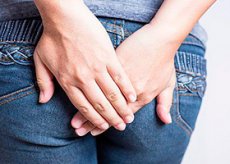Levator ani syndrome
Last reviewed: 23.04.2024

All iLive content is medically reviewed or fact checked to ensure as much factual accuracy as possible.
We have strict sourcing guidelines and only link to reputable media sites, academic research institutions and, whenever possible, medically peer reviewed studies. Note that the numbers in parentheses ([1], [2], etc.) are clickable links to these studies.
If you feel that any of our content is inaccurate, out-of-date, or otherwise questionable, please select it and press Ctrl + Enter.

A muscle syndrome that raises the anus is an episodic pain in the rectum, caused by a muscle spasm that raises the anus.
Proctalgia fugax (fast-passing pain in the rectum) and cocciogeny (pain in the coccygeal region) are variants of muscle syndrome that raises the anus. Spasm of the rectum causes pain, usually not associated with defecation, lasting less than 20 minutes. Pain can be short-term and intense or vague high in the rectum. Anal pain may occur spontaneously or be associated with the seat, and may also occur during sleep. Pain can cause sensations of difficulty passing through gases or feces. In severe cases, pain persists for hours and often recurs. In connection with these symptoms, patients sometimes undergo various operations on the rectum, however without sufficient effectiveness.
Diagnosis of a muscle syndrome that raises an anus
Physical examination allows you to exclude other pathological changes in the rectum causing pain syndrome (eg, hemorrhoids, cracks, abscesses). Most often the physical examination does not show any pathological changes, although, usually on the left, soreness and tightening of the muscle lifting the anus can be revealed. In rare cases, the cause of pain may be diseases of the pelvic or prostate gland.
 [1]
[1]
Treatment of muscle syndrome, raising the anus
Treatment of the muscle syndrome that lifts the anus is composed of explanations to the patient of the nature of this pathology. Acute episodes of pain can be reduced by the escape of gas or feces, sedentary baths and non-narcotic analgesics. In the case of more pronounced signs of the disease, physiotherapy with electro-galvanic stimulation of the lower parts of the rectum is effective. You can use muscle relaxants or an anal sphincter massage under local or regional anesthesia, but the effectiveness of such treatment is not fully understood.

